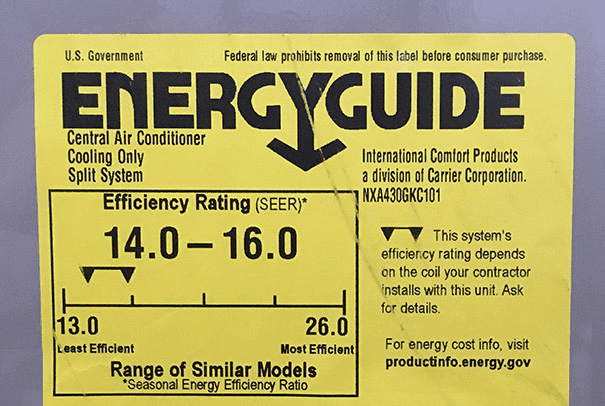In summary, choosing an AC unit with a high SEER rating can save you money on your energy bills and may also make you eligible for tax credits and other incentives. Consult with our professional HVAC technicians at Mechanical One to determine the best AC unit for your needs and take advantage of the energy-efficient benefits it can provide.

What is the SEER rating?
The SEER rating, or Seasonal Energy Efficiency Ratio, is a measure of the efficiency of an air conditioner. It is calculated by dividing the cooling output of the AC unit (measured in British Thermal Units, or BTUs) by the energy input (measured in watt-hours). The higher the SEER rating, the more efficient the AC unit is.
Types of SEER Ratings to Consider
There are several different SEER ratings for air conditioners, ranging from 13 to 21. The minimum SEER rating for an AC unit to be considered energy efficient is 14. Here are the different SEER ratings and what they mean:
- 14-15 SEER: AC units with a SEER rating of 14-15 are considered high efficiency. These units use less energy to cool your home or business, resulting in lower energy bills.
- 16-17 SEER: AC units with a SEER rating of 16-17 are considered very high efficiency. These units use even less energy to cool your home or business, resulting in even lower energy bills.
- 18-21 SEER: AC units with a SEER rating of 18-21 are considered ultra-high efficiency. These units are the most energy efficient on the market and can significantly reduce your energy bills.
It is important to consider the SEER rating of an AC unit because a more efficient unit will use less energy to cool your home or business, resulting in lower energy bills. A unit with a higher SEER rating may also be eligible for energy-efficient tax credits or rebates.
Energy Guide Label on a Air Conditioner
The energy guide label on an air conditioner is a standardized label that provides information about the energy efficiency of the unit. The label is required by the U.S. Department of Energy (DOE) for all air conditioners and heat pumps sold in the United States.+
To find the SEER rating on the energy guide label, look for the section labeled “Energy Efficiency Ratio (EER).” The SEER rating is typically listed in this section, alongside the cooling capacity of the unit (expressed in British Thermal Units per hour, or BTUs/hr). The SEER rating is a measure of the efficiency of the air conditioner, and is calculated by dividing the cooling capacity of the unit by the power input required to run it. A higher SEER rating indicates a more efficient air conditioner.
In addition to the SEER rating, the energy guide label also includes other important information about the unit, such as its cooling capacity, energy consumption, and operating costs. It may also include information about the unit’s features and warranties.
It’s important to note that the SEER rating listed on the energy guide label is the maximum rating that the unit can achieve under certain test conditions. In actual use, the unit may not achieve this maximum rating due to variations in temperature and humidity, as well as other factors.
SEER and its Tax Benefits
There are a few tax benefits to consider when buying a new air conditioning unit with a high SEER rating:
Federal tax credits: The federal government offers tax credits for energy-efficient home improvements, including the installation of a new AC unit with a high SEER rating. These credits are available through December 31, 2023.
State and local incentives: Many states and localities offer incentives, such as rebates or credits, for energy-efficient home improvements, including the installation of a new air condtioner unit with a high SEER rating.
Utility company incentives: Some utility companies offer incentives, such as rebates or credits, for energy-efficient home improvements, including the installation of a new AC unit with a high SEER rating.
It is important to note that these tax benefits and incentives may vary depending on your location and the specific AC unit you choose. It is a good idea to research the available tax credits and incentives in your area before making a decision on a new AC unit.
